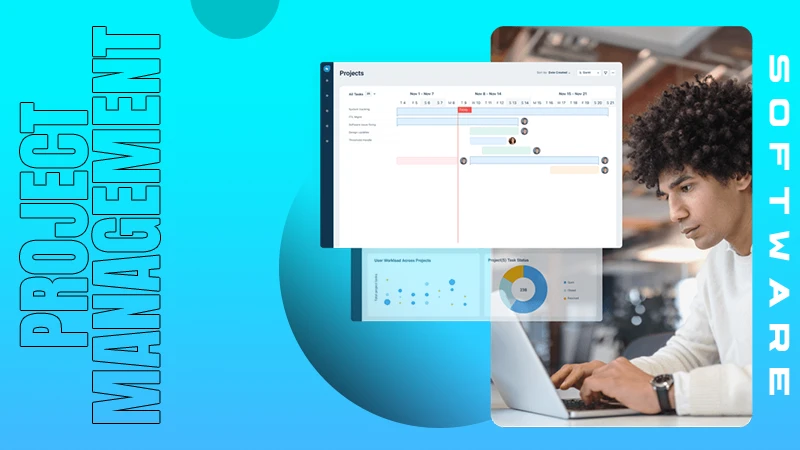Ans: Wrike, Jira, and Trello are some popular PMS tools these days.
Top 25 Revolutionary Project Management Software Tools That Actually Work (2025 Edition)
Are you also tired of messy spreadsheets and never-ending file sharing? All you need is project management software to transform how your team/business plans, executes, and delivers the tasks on time. Whether you are a large-scale enterprise or a startup, these tools help teams streamline tasks, track progress, and meet deadlines with clarity and ease.
Project management software empowers businesses to work smarter, not harder. With features like real-time tracking and data-driven reports, it has become a must-have for companies of all sizes. Moving further, in this immersive guide, you can discover 25 top project management tools to optimize your workflow and deliver quality results every time.
- What is Project Management Software?
- Why Does PMS Matter in Modern Organizations?
- Top 10 Best Project Management Software
- 15 Best Program Management Software
- What Should be the Core Features of a Project Management Software?
- Types of Software To Manage Projects
- How to Choose the Right Software for Your Business Needs?
- Conclusion
- FAQs
What is Project Management Software?
Project management software is a digital tool or platform that helps individuals and organizations track and manage projects efficiently. It tends to simplify complex tasks by offering features like task allocation, scheduling, progress tracking, file sharing, and seamless communication among all the team members.
Whether you are managing a small team or a large enterprise, the project manager software provides a centralized platform to streamline the tasks, monitor deadlines, and collaborate in the real world.
Running a business has never been easy, and using tools like CRM software or PMS platforms enhances productivity, improves accountability, and makes every project a success. Reducing delays and avoiding miscommunication, these management tools make sure that every member stays on the same page.
Why Does PMS Matter in Modern Organizations?
In today’s digital-driven work environment, project management software tools play a critical role in the success of the organization. It not only helps streamline operations and increase productivity but also ensures that the team stays aligned with their goals. Without a centralized system, managing multiple tasks and meeting deadlines might become chaotic and impossible.
Moving further, let us explore some undeniable benefits of the paid or free project management software.
- Improved Collaboration: PMS allows the team members to share files, comments, and updates all in one place, promoting transparency and real-time coordination.
- Efficient Task Management: Enables clear allocation of responsibilities and tracking of deadlines, therefore reducing confusion and missed tasks.
- Better Time Management: With built-in scheduling tools and reminders, employees or team members can stay on track and avoid any last-minute hassle.
- Resource Utilization: It helps allocate resources like time, manpower, and budget more efficiently.
- Better Decision-Making: PMS allows for offering analytics and performance reports, which help the project leaders to make informed decisions, depending on the insights.
- Enhanced Accountability: Project management software enlightens everyone about what they are responsible for, fostering a culture of ownership and reliability.
One can say that project management software is not just a productivity tool; it is an asset for organizations, no matter how big or small. It helps enterprises adapt to change, manage complex tasks, and drive results, making it an essential investment in today’s competitive business world.
Also Read: ERP vs CRM: Understand the Key Differences, Functions, Benefits, and More
Top 10 Best Project Management Software
Choosing the right tool can make or break the business. Without any further ado, let us quickly explore the top 10 project management software tools along with their features and pricing models.
1. Trello
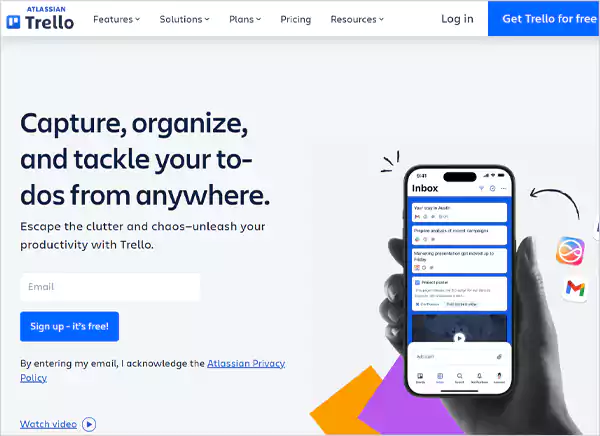
Trello is a project management tool based on the Kanban board structure. It is mostly ideal for task tracking and collaboration, and it offers a free plan with essential features.
The standard paid version starts at $5 per user per month. Trello also provides a 14-day free trial on its premium subscription.
| Pros | Cons |
| Easy to use GUI | Limited features in the free plan |
| Great for visual task management | Not suitable for complex projects |
| Seamless integration with other applications |
2. Asana
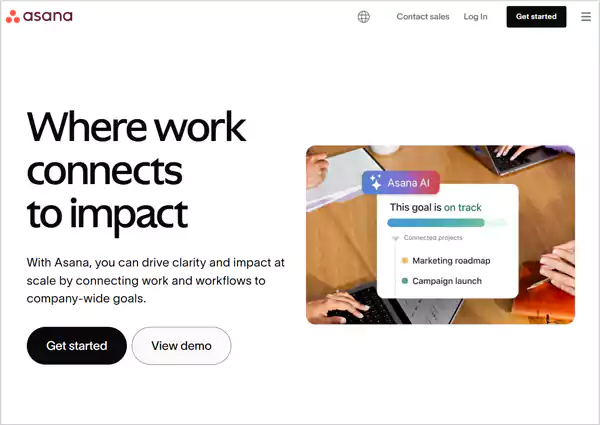
Asana is a flexible and seamless task management platform perfect for businesses having teams of all sizes. It offers a free basic plan, while the paid version begins at $10.99 per user, billed annually. A 30-day free trial is available for premium plans and features
| Pros | Cons |
| User-friendly interface | No built-in time tracker |
| Supports multiple project views | Advanced features are available only in the premium plan |
| Workflow tools are amazing |
3. Monday.com

Monday is a visually detailed operating system for project management, customer relationship management, and workflows. The paid plans start at $9 per user per month, and the tool also offers a 14-day free trial with no credit card required.
| Pros | Cons |
| A customization option is available | Slightly overwhelming interface |
| Projects can be color-coded for clarity | Limited features in the free version |
| Seamlessly integrates with popular tools |
4. ClickUp
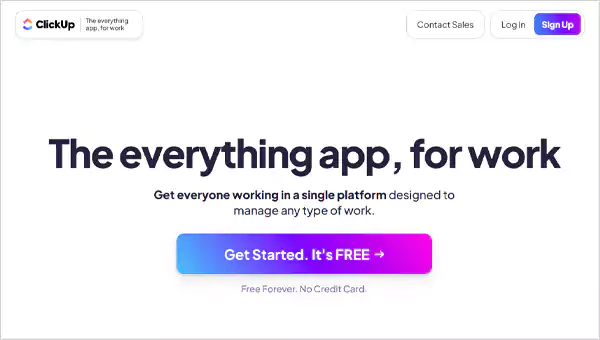
ClickUp is an all-in-one best pm software and a productivity tool that combines tasks, files, goals, and chats. It has a free forever plan, and its paid plan begins at $7 per user per month. For all the premium plans, a 14-day free trial is also available.
| Pros | Cons |
| So many advanced features and tools are available | Too complex GUI |
| Dashboards and task boards can be customized | The project screen is cluttered and oversized |
| Even the free plan offers good functionalities |
5. Wrike

Wrike is a robust project management software with all the advanced features. If you need a centralized platform for all your projects, this tool is for you. The paid plans start at $9.80 per user per month, and a 14-day free trial is also offered in the premium plan.
| Pros | Cons |
| You can access the activity and performance reports in real time | Complex user interface |
| Powerful analytics and data insights are given | More expensive than some alternatives having the same features |
| Suitable for large-scale projects |
6. Notion
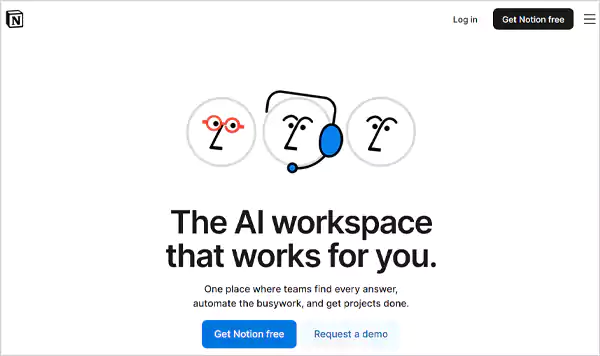
Notion is a minimalist and flexible program management tool. It is like a secure workspace for notes, tasks, and project tracking. The platform offers a free personal plan, while the business plan starts at $8 per user per month. A free 7-day trial is available on all the premium plans.
| Pros | Cons |
| Can do note-taking and project tracking at the same time | Not suitable for complex projects |
| Customizable templates are available | No built-in Gantt charts available, and limited offline access |
| Beautiful and funky GUI |
7. Basecamp
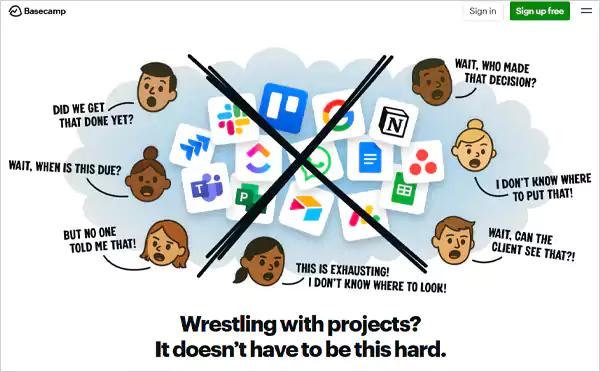
Basecamp is a simple, all-in-one project management software and team collaboration tool. It offers a free plan for personal use, while the business plan starts at $299 per year for unlimited users. A 30-day free trial is also available.
| Pros | Cons |
| Yearly pricing, effective for large-scale enterprises | Time tracking functionality is not available |
| Easy to use interface and requires minimal setup | Not ideal for ultra complex projects. |
| Combining charts, files, messages, and tasks all in one place |
8. Jira
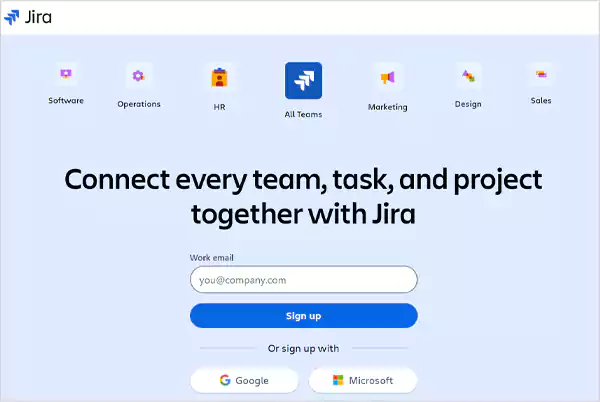
Jira, developed by Atlassian, is a powerful and one of the most popular project management software tools, suitable for agile tasks. You can customize your workflow and track the changes anytime and anywhere. It offers a free plan for up to 10 users, and the paid plan starts at $7.75 per user per month with a 7-day free trial.
| Pros | Cons |
| Excellent for agile and scrum frameworks | Not suitable for non-tech employees |
| Customizable templates are available | Complex UI for beginners and an expensive plan |
| Integration with other complex tools |
9. Smartsheet

Smartsheet is a spreadsheet-like program management tool mostly used for planning, automation, and reporting. The paid plan starts at $7 per user per month, with a 30-day free trial plan that includes all the features.
| Pros | Cons |
| The interface is similar to a spreadsheet | Limited features are available in the basic plan |
| Well-built automation and reporting tools | Outdated interface and not appealing to first-time users |
| Scalable for enterprise use |
10. Microsoft Planner
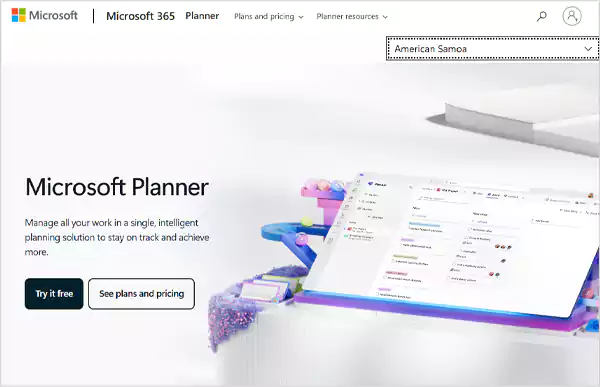
The Microsoft Planner is a professional-grade PMS tool, standing tall in the field, and is mainly used for large-scale projects.
It gives you intelligent planning solutions, allowing you to complete your tasks on time. Pricing starts at $10 per user per month for cloud-based, and there is a free 1-month trial plan for Microsoft 365 users.
| Pros | Cons |
| Comprehensive planning, scheduling, and tracking can be done | An expensive plan for small teams |
| Works well with other Microsoft tools | The Mac version is not available |
| Strong Gantt chart and reporting features |
The ideal project management tool depends on the needs of the projects, budget, and preferred work style. From simple task management tools to complex software, each PMS has something unique. Always start with a free trial to check whether the program enhances your workflow or not.
15 Best Program Management Software
Explored the above-mentioned project management tools, but are still looking for more options? No worries! We have got you covered. Given below are 15 more powerful and reliable tools that are budget-friendly and are suitable for large-scale enterprises.
| PMS Name | Starting Price | Free Trial |
| Teamwork | $5.99 per user per month | 30 days |
| Adobe Workfront | Depends on the number of users and features | Demo session |
| Proofhub | $45 per month | 14 days |
| Scoro | $26 per user per month | 14 days |
| Airtable | $20 per user per month | 14 days |
| Freedcamp | Free | Free |
| Redbooth | $9 per user per month | 14 days |
| nTask | $3 per user per month | 14 days |
| GanttPRO | $7.99 per user per month | 14 days |
| Hive | $12 per user per month | 14 days |
| Workzone | Custom pricing | On request |
| Podio | $11.20 per user per month | 14 days |
| MeisterTask | $6.50 per user per month | Basic plan — free14 day for PRO |
| Bitrix24 | $49 per month | Varies |
| Paymo | $5.95 per user per month | 15 days |
With these 15 additional tools, you now have 25 solid project management software tools to choose from. Whether you are an enterprise, a startup, or planning to grow your business, every workflow needs a PMS to be efficient and stay productive in the market.
What Should be the Core Features of a Project Management Software?
A powerful project tracking management software should offer a comprehensive and holistic set of tools that make planning, implementing, and executing the project easier and efficient.
If you are running a business, cutting-edge tools like SAP and PMS are a must-have. Given below are some core features that every management tool should have to ensure smooth functioning.
| Task Management: The task management in software project should be efficient. It should create, assign, prioritize, and track tasks to ensure productivity. |
| Planning and Scheduling: Visual tools like Gantt charts or calendars help in effective planning of the timeline and allow for mapping project stages. |
| Team Collaboration: Integrated chat, comments, and file sharing keep everyone in the team connected and informed about any updates. |
| Time Tracking: Every project management software should have a time tracker to monitor how long a particular task takes to improve productivity and meet deadlines. |
| Resource Management: A feature that allocates team members, budget, and essential tools across multiple projects. |
| File Sharing and Management: Store, organize, and access important project files, all in one centralized location. Integration with cloud storage to ensure flexibility. |
| Reports and Analysis: Every PMS should be able to generate review reports to analyze the progress of the task and track the performance of the members to make data-driven decisions. |
| Integration Capabilities: Just like cloud storage, a project management software should be able to have a seamless connection with essential tools like Slack, Google Workspace, or Zoom to boost the workflow. |
| Mobile-Friendly Application: A mobile-friendly interface enables the members to perform certain tasks on the go and be sure of all the updates or upcoming tasks. |
In short, the best project management softwares should support every stage of a task from its initiation till its completion.
By offering the above core features, it empowers and encourages the team members to perform well, collaborate better, and drive successful outcomes, hence creating a motivational work environment.
Types of Software to Manage Projects
Nowadays, all modern organizations have access to a variety of project management software types, each catering to different workflows and the distinctive needs of the project. Choosing the right type depends on the nature of the project or if the client has certain specific demands.
Given below is an elaboration on common types of project management software that businesses usually like to work with. From simple to complex, each PMS has its unique attributes depending on the project scope, the industry, and the methodologies that the organization may prefer following.
| PMS Type | Purpose | Examples |
| Task Management Software | Focuses on tracking individual tasks and deadlines. Best for simple and small projects. | 1. Todoist 2. Microsoft To Do 3. Any.do |
| Collaborative PMS | Enables real-time communication and teamwork. Best for file sharing and task boards. | 1. Trello 2. Asana 3. ClickUp |
| Agile PM Tools | Supports agile methodology with backlog management. Best for software development and fast-paced tasks. | 1. Jira 2. Monday.com 3. Zoho Sprints |
| All-in-One PMS | Combines task tracking, communication, reporting, and planning. Best for an enterprise and complex multi-department projects. | 1. Wrike 2. Smartsheet 3. Microsoft Project |
| Cloud-Based PMS | Access data anytime, anywhere via the internet. Best for remote teams and businesses with flexible work modes. | 1. Basecamp 2. Teamwork 3. Notion |
| On-Premise PMS | Installed and hosted within an organization’s own server. Best for businesses needing offline access. | 1. Microsoft Project 2. RationalPlan |
With so many types of project management software available, businesses can easily find a solution that aligns with their needs and specific targets that they wish to achieve. Whether you are looking to manage a simple task or a complex project, there is a PMS for everyone out there.
Also Read: Top ERP System Examples: Best Business Management Tools You Must Know About
How to Choose the Right Software for Your Business Needs?
Selecting the right project management software is a crucial step that can directly impact the productivity and target of your project. With so many types and options available, businesses sometimes can make wrong choices.
Given below are some criteria that you should keep in mind before finalizing a PMS for your business or project.
- Analyze Your Requirements: Make a list of all the features that you wish your project management software should have. Understand your project and team size, and assess the budget.
- Define Your Budget: Analyze how much you can willingly invest monthly or annually. Make sure to consider both paid and free pm software.
- Easy GUI: The software should have a user-friendly interface so that every member of the team can adopt it without any heavy training.
- Integration and Scalability: Choose a tool that grows as per the needs of your business, and ensure that it integrates with the tools that you are already using for a smooth and seamless transition.
- Mobile Access: It is always beneficial to go for a PMS that has a mobile-friendly interface so that remote or hybrid teams can access any project, eventually making them productive.
Before you decide to go for project managing software, consider taking a demo session or opting for free trials so that you can have a brief idea about the tool and its functionality. Carefully evaluate your goals, team dynamics, and future targets before committing to a tool.
Conclusion
In a world where productivity and clarity drive success for businesses, good project management software has become an indispensable asset. By choosing the right tool, companies can stay organized, meet their targets faster, and reduce chaos.
Whether it’s about tracking a simple task or planning an enterprise-level project, the right actionable PMS has you covered. These tools are not just about trends; they have now become a necessity. Go ahead and make your choice for a smoother, smarter, and faster workflow!
FAQs
Q: What is the most popular project management software?
Q: Does Microsoft Office 365 have a project management tool?
Ans: Yes, Microsoft Office 365 has its own PMS tool.
Q: What is the best CRM for project management?
Ans: Hubspot, ZohoCRM, and Pipedrive are some top CRMs for project management.
Q: Is CRM a project management tool?
Ans: While CRM refers to customer relationship management, it can be used alongside PMS for better results.
Q: What is SAP?
Ans: SAP stands for Systems, Applications & Products in Data Processing and is a multinational ERP company.
Sources
